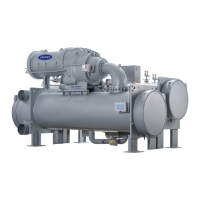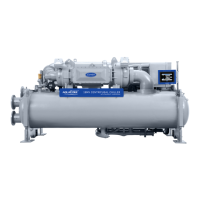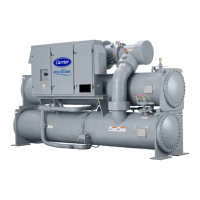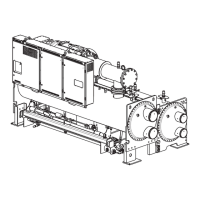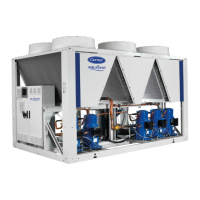91
CHANGING OIL — The 23XRV oil pump and filter can be
isolated to change the oil filter and oil while the refrigerant re-
mains inside the chiller. Use the following procedures to
change the oil and oil filter (if required):
1. Make sure the compressor is off and the CB1 main circuit
breaker for the control center is open.
2. Open the CB2 control power and oil heater circuit break-
er in order to turn off the power to the oil heater.
3. Record the oil level observed in the oil sump sight glass.
4. Connect an oil charging hose to the oil drain valve on the
strainer housing. See Fig. 5-7. Place the other end of the
oil charging hose in a clean container suitable for used oil.
A portion of the oil drained from the sump should be used
as an oil sample and should be sent to a laboratory for
proper analysis. Do not contaminate this sample.
5. Slowly open the drain valve in order to drain the oil from
the sump.
6. Charge new oil through the drain valve on the strainer
housing. A hand pump or portable electric oil pump will
be required to charge oil back into the oil sump against re-
frigerant pressure.
7. Add oil (approximately 10 gal [38 L]) until it returns to
the level noted in Step 3. The oil sight glass will not fill
completely since a small amount of gas will be trapped
inside (even under vacuum conditions).
8. Apply power through the CB2 controls and oil heater
circuit breaker.
Changing Oil Filter
1. Make sure the compressor is off and the disconnect for
the compressor starter is open.
2. Close both oil filter isolation valves. See Fig. 54.
3. Place a container underneath the oil filter assembly.
4. When a Schrader valve is provided, use it to relieve the
pressure. Slowly open the drain plug, located on the
bottom of the oil filter housing, to relieve pressure. Do
not remove the plug.
5. Remove the filter canisters by unscrewing the retainer
nut. The filter may now be removed and disposed of
properly.
6. Install new oil filter. Install the new O-ring. Tighten the
retainer nut.
7. If a Schrader valve is supplied, evacuate the oil filter by
connecting the vacuum pump to the Schrader valve.
8. Slowly open the isolation valve located near the oil pump
to equalize the pressure. Fully open both oil filter isola-
tion valves.
Oil Specification — If oil is to be added, it must meet the
following Carrier specifications:
Carrier Part Number . . . . . . . PP23BZ110001 (1x1 gal. can)
. . . . . . . . . . . . . . . . . . . . . . . . . . PP23BZ110005 (1x5 gal. can)
Oil type. . . . . . . . . . . . . . . . . . . . .Inhibited polyolester-based
synthetic compressor lubricant suitable for use
in screw compressors where high viscosity
and compatibility with HFC-134a
refrigerants is required.
ISO Viscosity Grade . . . . . . . . . . . . . . . . . . . . . . . . . . . . . 220
Specific Gravity . . . . . . . . . . . . . . . . . . . . . . . . . . . . . . . .0.981
Viscosity, cSt at 40 C (104 F) . . . . . . . . . . . . . . . . 198 to 242
cSt at 100 C (212 F) . . . . . . . . . . . . . . . . . .18 to 21
SSU at 100 F (38 C) . . . . . . . . . . . . . . . 1005 ± 100
SSU at 210 F (99 C) . . . . . . . . . . . . . . . . . . . 91 ± 7
Pour Point (maximum) . . . . . . . . . . . . . . . . . . . .–6 F (–21 C)
Flash Point (minimum) . . . . . . . . . . . . . . . . . . .428 F (220 C)
Moisture Content (maximum) . . . . . . . . . . . . . . . . . . 50 ppm
Acid Number (maximum). . . . . . . . . . . .0.15 mg KOH/gram
Critical Solution Temperature with HFC-134a (maximum)
. . . . . . . . . . . . . . . . . . . . . . . . . . . . . . . . . . . . . . . . . –8 F(–22 C)
This oil (part number PP23BZ110001 [1x1 gal. can] and
PP23BZ110005 [1x5 gal. can]) may be ordered from your
local Carrier representative.
Oil Heater — Inspect the oil heater for carbon build-up on
the heating element if an adequate oil sump temperature cannot
be maintained when the chiller is shut down. It may be neces-
sary to temporarily install the heater element terminal cover to
provide additional leverage while threading the oil heater into
the sump. The sump oil heater elements must be positioned
vertically to allow proper heat convection. See Fig. 54 and 55.
The heater element must be installed with the word “TOP” on
the threaded fitting facing upward.
Refrigerant Filter/Drier — A refrigerant filter/drier, lo-
cated on the motor cooling line, should be changed once every
two years, or as necessary, if the condition of the filter indicates
a need for less or more frequent replacement (see Fig. 56). A
moisture indicator (dry eye) sight glass is located beyond the
filter/drier to indicate the concentration of moisture in the
refrigerant. If the moisture indicator indicates moisture, locate
the source of the liquid immediately by performing a thorough
leak check. Close the isolation valves on either side of the filter
drier. Use the Schrader valve to relieve pressure in the isolated
filter/drier. Replace the filter/drier and evacuate the isolated
section of tubing with a vacuum pump attached to the Schrader
valve.
Oil Strainers — The oil reclaim system has two strainers.
One is installed in the VFD refrigerant cooling line between the
cooler and condenser. The second strainer is located in the oil
sump strainer housing (see Fig. 54). The oil sump strainer must
be replaced or inspected with the refrigerant charge isolated in
the condenser. Inspect the oil sump strainer for obstructions or
damage every time the oil is changed. The strainer threads into
the oil sump strainer housing. Install a new strainer o-ring if the
entire strainer does not require replacement.
VFD Refrigerant Strainer — A refrigerant strainer is
located in the line that supplies refrigerant to the VFD. Three
isolation valves in the refrigerant cooling lines must be closed
before this strainer is changed. See Fig. 56.
Vaporizer Refrigerant Return Line Orifice —
There is a metering orifice where the refrigerant return line at-
taches to the vaporizer (see Fig. 54). This orifice can only be
inspected by cutting the vaporizer refrigerant return line near
the vaporizer. This orifice should be inspected if hot condenser
gas flow through the vaporizer appears to be obstructed.
CAUTION
Be sure the power to the oil heater is off when the oil sump
is drained. If the oil heater remains energized when the
sump is empty, it will overheat any residual oil on the heat-
ing element and become fouled. Overheating the elements
will also significantly reduce their useful life.
WARNING
The oil sump is at high pressure. Relieve pressure slowly to
prevent injury.
CAUTION
Compressor oil is hygroscopic. Containers should remain
tightly sealed in a clean and dry environment to prevent
moisture absorption from the air.
516

